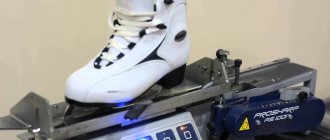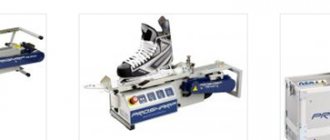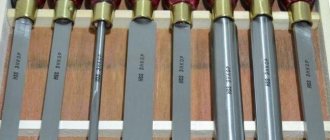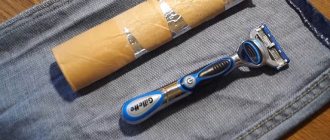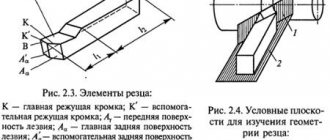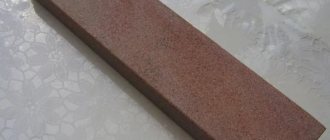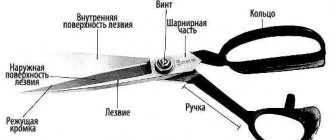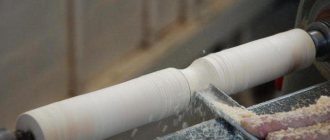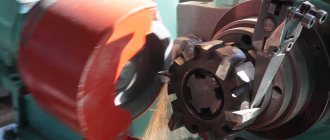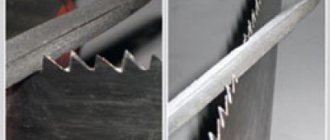Have your skates begun to glide poorly and become unresponsive when turning? So it's time to think about sharpening! Taking care of your blades will not only restore your former speed on the ice, but will also allow you to customize your skates to suit you. But it’s better to take them to a workshop, because sharpening a cutting edge is far from easy...
Skates, like any other sports equipment, require regular care. The main element is the cutting edge, which digs into the ice during skating under the weight of the weight, becoming dull and deformed over time.
Damage or loss of sharpness of the skate affects:
- sliding speed;
- acceleration rate;
- maneuverability on ice.
Therefore, when you notice that your skates have begun to behave differently, pay attention to sharpening. If the edge is dull, it needs to be corrected urgently. Otherwise, you risk either completely ruining your skates or getting injured. Plus, it’s always more enjoyable to skate on good skates, and during active recreation, it’s the sensations and emotions that matter.
If your skates look like this, then it's high time you thought about sharpening them!
Profiling hockey skate blades
Professionally made sharpening allows the skates to have maximum gliding and contact with the ice.
Blade preparation occurs in two stages:
- Profiling. They change the geometry of the blade to suit the individual characteristics of the hockey player.
- Hockey skate sharpening (gutter sharpening).
- Blade profile (profile radius) - the contour of the blade from toe to heel.
- The central top point on the blade. She takes on all the load when riding.
- An area or spot that touches the ice.
The platform is the main working part of the skate. Responsible for stability and speed. The greater the weight and height of the hockey player, the larger the size of the spot in contact with the ice.
The profile radius affects the player’s maneuverability, but if you increase it, you can worsen the stability of the skate on the ice. An athlete of great weight and height should have a larger profile radius. This will help the skate to better contact the surface.
Each player on the ice has his own task. Therefore, the profile of a defender is not suitable for a striker. For a hockey player, it is important to find a balance between agility and stability on the ice.
The factory parameters of the circuit, as a rule, are insufficient for normal movement of a hockey player during the game.
The standard pad size does not exceed 10 mm, and the rib sharpening radius is 13-15 feet.
There are three methods to increase the contact patch with ice:
- profile “Site”;
- single (classic, radius);
- combined (double, triple).
Benefits of sharpened skates
Properly prepared skates have a number of advantages:
Provides improved balance and better ride control. The legs do not slip, it is easier to balance and maintain balance when turning;
Reduced friction, improved sliding quality. The friction force is less, therefore less effort is spent on skating;
Maneuverability and acceleration. You can play more aggressively, good grip on the surface provides acceptable maneuverability, you can push off harder without the risk of slipping, and accordingly the acceleration becomes sharper.
Classic profile
The radius longitudinal profile is measured by the radius in feet. For example: 14″ designation means the radius of the profile template is 14 feet. Used for profiling the blades of hockey skates: children's, beginner hockey players and amateurs. Sharpening is done on machines according to factory patterns with a sharpening radius from 7″ to 30″.
The most popular single profile patterns for children's skates:
- 11″ - for small players with good skating skills;
- 15″ - for young beginners;
- 17″ - for beginner young players with a lot of weight.
Combined profiling method
The blade of a hockey skate can be divided into three working zones: toe, middle, heel. Each zone is responsible for performing its own maneuver (turn, turn, slide).
The essence of the method. Each part of the blade has its own spot of contact with the ice. After profiling, a blade with a complex configuration is obtained. Sharpening is carried out only on specialized machines using templates. This method is popular among professional players.
Detroit Templates
A dual sharpening style for ice hockey skates like the Detroit 1 (10-20ft) provides the player with the most stability on the ice. At the same time, speed and maneuverability are slightly reduced.
For goalies, players who skate a lot with their backs forward, and heavy defensive players, the Detroit 2 (13-26 feet) is suitable.
Zuperior Templates
The triple type of sharpening is used to increase balance, speed, and maneuverability.
Useful tips
The frequency of sharpening skates depends on how actively the player skates. With regular training 4-5 times a week, sharpening should be done every 3 days. Professional athletes easily feel the need to sharpen their skating quality. Young hockey players should focus on the following nuances: Socks move apart on the ice. Burrs and roughness are visible on the edge. If you run a blade across the skin, it will leave scratches.
Visually inspect the site. Important information! On the bottom of the blade the layer of metal is 1-2 mm. When sharpening, the machine removes no more than 0.1 mm. After 20 sharpenings, the equipment becomes unsuitable for riding. Another question that worries beginners is whether it is worth sharpening new ammunition. Only Reebok produces ready-to-skate skates (model with T-blade).
Types of sharpening hockey skates
The convenience of play and the safety of the athlete depends on the correct sharpening of hockey skates. There are several standards that apply during the procedure.
The basic term is groove (gutter). You can often see names such as radius, notch, groove.
The sharpening radius (groove depth) is affected by:
- athlete's weight;
- hockey player's skating style;
- hockey player skill level.
The numbers in the table indicate the depth of the groove. In this case, the lower the value, the deeper the recess will be and the sharper the edges. More value means less depth of the groove, less sharpness of the edge.
Table of standard groove values for sharpening hockey skates of a forward
Sharpening figure skates
Here are some common mistakes made when sharpening by non-professionals:
- When sharpening in an artisanal way, the sides of the blades turn out to be unequal. As a result, when skating, a person loses his balance.
- Also, beginners who do not know how to sharpen figure skates incorrectly remove steel from various parts of the blades. For example, they remove a lot of steel in the toe area. The result is imbalance and lack of support for the blade on the ice.
Important! Also remember that the quality of the ride will deteriorate due to the incorrect radius of the groove. The unit of measurement for this value is inch. This value shows the recommended sharpening radius. The radius of the groove affects the correct sliding and comfort when exiting jumps. The radius of the gutter is selected individually for skaters.
How to sharpen skates at home
You don't have to be a professional figure skater to skate with well-sharpened blades. Any sports equipment must be properly cared for and updated on time. If your skates have become dull and lost their sharpness, but you do not plan to go to a specialized service, we suggest learning a few simple ways to sharpen skates with your own hands at home without a machine.
Sharpening hockey skates
When it comes to how to sharpen hockey skates, the most important thing is choosing the right type of sharpening. Here are some options:
- With standard hockey sharpening, the grooves of the blade are sharpened in a semicircle. There are also rounded channels.
- The peculiarity of channel z sharpening is the presence of a groove with square channels in the center.
- The least common type of sharpening is FTB. It is sharpened only on Blackstone machines. This type of sharpening is not common in the CIS countries.
Also, when wondering how to sharpen hockey skates, users should remember that skates with a standard channel are sharpened not only on manual, but also on automatic machines. This method of sharpening is the most reliable. Using Z sharpening, you can solve the problem with slippage. It also helps sharpen deeper grooves than conventional sharpening. This type of groove has been tested on European athletes for a long time, and it has been proven that it is superior to standard grooves in all respects. Among the advantages of FTB sharpening, it is worth highlighting its high efficiency, which is defined as follows: a small loss of speed and excellent grinding. However, this sharpening has its drawbacks - it is inconvenient to use a machine made by Blackstone. The fact is that to sharpen different grooves it is necessary to change heads and adjust the machines. This takes a lot of time.
Tip: To get a higher rolling speed, use grooves of different radii. Don't forget that different sharpening points are used for different riding styles.
So, sharpening figure or hockey skates is very simple - the main thing is to follow the advice given in this article. Happy skating!
helperlife.ru
Why do you need to sharpen skates?
The blade loses its original shape quite quickly, especially if the skates are used quite often. What does timely and correct sharpening give:
- Increased stability and improved balance;
- Control of placing the blade on the ice;
- Ability to perform complex tricks and fast spins;
- Acceleration of movement on the skating rink;
- Improved gliding;
- Comfortable acceleration and braking at any time.
So, what signals indicate the need for the procedure:
- Difficulty with timely braking;
- Slipping of the metal profile;
- Inability to accelerate to the desired speed;
- Move in any direction when maneuvering and turning;
- The absence of a groove on the surface of the blade (most often found on completely new products that have never been used);
- Rust on the groove (if the skates have not been used for a long time and storage rules have been violated).
The greater the person's weight, the more closely the contour of the boot blade should be in contact with the ice. This will evenly distribute the weight of the athlete and maintain balance when riding.
How and with what you can sharpen skates at home
Blades can be sharpened only with tools that are significantly harder than the metal contour itself.
What you will need to purchase:
- Electric emery (removes burrs and irregularities from the surface of the blade) and sandpaper;
- A small thin round file or “needle file” – with a diameter of up to 10 mm or equal to the thickness of the ridge (evens out the groove);
- A vice (needed to make it convenient to work by clamping the skates with the blades up and fixing them in this position);
- Special sharpening fine-grained wooden block.
If you learn how to properly sharpen skates with your own hands at home, you can not only save time and money, but also acquire useful skills. The video below shows the process of sharpening a blade edge without special equipment using a needle file.
Subtleties of skate care
If sports equipment is not properly cared for, it will quickly lose its aesthetic appearance and fail. Moreover, attention should be paid not only to the condition of the boots, but also to the metal blades. After all, it is thanks to them that we can glide smoothly on the ice, maintaining balance when turning and braking.
How to care for your skates:
- The main enemy of metal is rust! Therefore, the blades must be cleaned of adhering snow and ice after each trip to the skating rink, and only then wipe dry the remaining metal parts (screws, protrusions, groove, etc.), put a hard cover on top and put it in a sports bag. It is also recommended to use soft covers under each blade for better drying;
- Boots must be broken in correctly, otherwise cracks, deformed areas and stretch marks may appear on the material. Proper drying of products is also important - in no case on radiators, but naturally, unlaced, inside a well-ventilated room;
- Determining the need for sharpening - visually the blade should be sharp, like a freshly sharpened knife. Also, a large number of small nicks and burrs will mean that the skates could use sharpening. The main indicator is the correct shape of the groove. It should be semicircular, resembling a concave arc.
If you have little experience or are a beginner, it is still better to take your skates to a special service and show them to a specialist, because safety on the ice comes first! In no case should you underestimate the importance of timely sharpening of skates; below you can see how to do the work yourself at home without a machine with step-by-step instructions in the video.
How to avoid mistakes
A common misconception is that any skates can be sharpened like kitchen knives, leaving only one sharp edge. This method completely deprives the athlete of stability, worsening the grip on ice, which is provided by a special groove (groove) on the blade.
Under the influence of friction of two planes of the blade formed by the groove, the ice melts - and a thin layer of water is formed in the groove, which improves gliding. Moreover, thanks to the groove, friction increases.
- The appropriate groove depth for figure skating is 5-6 millimeters.
- If skates are part of hockey equipment - 20 mm.
- For speed skaters – up to 45 mm.
Blade shape
First of all, when sharpening, it is important to determine the appropriate blade shape. Select the sharpening option itself and calculate its parameters.
The point of contact of the ridge looks like 2 parallel sharp edges with a special recess between them.
The edges are called pads or ribs, and they provide traction and allow you to stand and maneuver without too much trouble. Depending on the sharpening, the edges can be straight or rounded inside. They should also be the same on both sides, otherwise you will be skewed in one direction or the other.
The recess is called a groove or groove and serves to reduce friction. The deeper the gutter, the more water accumulates in it when rolling (it is the water layer that reduces friction). But it's important to remember that increasing depth = decreasing rib thickness, which makes it harder to balance.
Today there are 3 most popular sharpening options:
Standard (regular gutter). Semicircular gutter with a radius from 6 to 40 and planting depth depending on the preferences of the skate owner. The most common method, which has been proving its practicality for many years. Suitable for hockey and figure skates.
Channel-Z (Z sharpening). A modern European approach to sharpening that is unique by turning two grooves:
- External. Similar to the standard version, semicircular.
- Interior. An additional square channel that is placed in the middle of the outer gutter.
It has better performance compared to the standard approach, but is technologically more complex. With such sharpening, workshop equipment noticeably suffers, which makes it a less common and more expensive option. Suitable for experienced fans of both figure and hockey skates.
FBV. An old Canadian version that did not take root in Russia and Europe. The gutter has a trapezoidal channel, this creates rigid adhesion to ice and excellent stability. True, the price for comfort on ice is fragility and fragility, because trapezoidal walls are thinner and quickly wear out when in contact with a hard surface. Used primarily by professional hockey players.
Preparation for sharpening
When figuring out how to sharpen skates at home, you should remember five rules:
- For turning, only the recommended tool is used, which must be harder than the steel from which the runners are made;
- The planes of the blade (ribs) after turning should be of uniform thickness;
- We must try to preserve or restore the original configuration of the blade;
- The sole of the blade is sharpened at right angles to the ribs.
There is an opinion that the second and all subsequent sharpening of the runners consists precisely in restoring the original dimensions of the groove.
Flat Bottom V (FBV)
The latest trapezoidal sharpening type developed over 20 years ago in North America. It is considered the most effective in terms of efficiency of all listed types. Actively used by hockey players in the NHL.
It is turned only on professional BLACKSTONE and BLADEMASTER machines, which creates difficulties for hockey players in Russia. The companies are not represented on the Russian market; you will have to pay dearly for replacing elements or new sharpening.
The essence of FBV sharpening lies in the peculiar shape of the groove. The channel in the inner plane of the blade is sharpened along a trapezoid. Due to this, a more rigid grip on ice is created, but ease of sliding is maintained. Sharp edges give the skates stability for maneuvers.
It is worth noting that in addition to the price, there is an equally significant disadvantage - the blade grinds off faster with this type of sharpening. Despite this, FBV has recently been gaining popularity in Russia among hockey players.
Sharpening
At home, you can resort to one of two methods - sharpening with a needle file or a grinding wheel. The first is technically simpler, but also more labor-intensive, requires greater physical effort, and is suitable for infrequent use of skates. The second one is faster, but requires more complex tools, and is recommended for those who skate or play hockey frequently.
File
Required:
- Vise;
- U-shaped wooden block;
- Round needle file of suitable diameter.
The file is inserted into the block, the skate is clamped in a vice. The block should be placed on the front of the blade and the contours of the groove should be marked in a reverse motion.
After comparing the ribs and making sure that their thickness is the same, a recess of the required depth is made. After that, the burrs are removed with a flat needle file or a small file.
Grinding wheel
Required:
- Grinder saw or electric drill;
- Grinding wheel, 0.5-1 mm narrower than the width of the groove;
- Steel corner and clamps or other device with height adjustment for attaching the ridge.
The ridge is secured and the contours of the groove are manually drawn. Sharpening is carried out with a grinder or a fixed drill, starting from the front of the blade and adjusting the height.
Examination
To ensure the correctness and perfection of sharpening, a check in four stages will allow you to check:
- Inspect the blades - the ribs should be symmetrical, without chips or chips;
- Take a piece of thin plastic and run along the blade in each area with the same force - the blade is sharpened well if scratches of the same depth have formed on the plastic;
- Place the skates on the ice - well-sharpened ones will stand straight, without tilting to one side;
- Put on your skates, go out on the ice and make sure they don’t slip when you take off.
If you notice any shortcomings, you should repeat the procedure until the result is 100% satisfactory.

